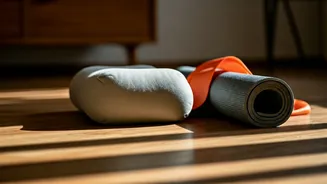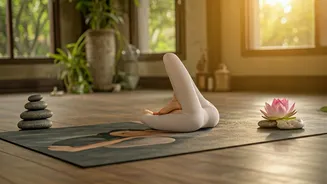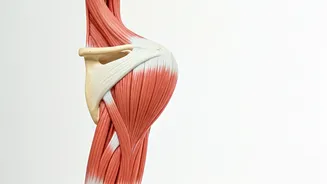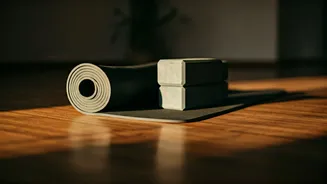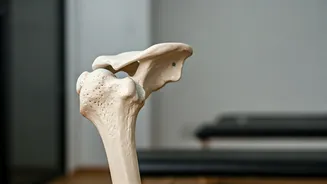Understanding Lower Back Pain
Lower back pain is a prevalent issue affecting countless individuals. Various factors contribute to it, including poor posture, muscle strains, and underlying
conditions. Understanding the causes is the first step towards finding effective relief. Common triggers include prolonged sitting, heavy lifting, and sudden movements. The pain can range from a dull ache to sharp, intense sensations, impacting daily activities and quality of life. Implementing a regular stretching routine can help address these issues by promoting flexibility and strengthening supporting muscles. Knowing the source of the pain allows for targeted exercises to provide significant comfort and prevent future problems. Seeking professional advice from a healthcare provider remains vital if the pain persists or worsens.
Knee-to-Chest Stretch
The knee-to-chest stretch is a fundamental exercise for relieving lower back pain. It is gentle yet effective. To perform it, lie on your back with your knees bent and feet flat on the floor. Gently bring one knee towards your chest, clasping your hands around the shin. Hold this position for approximately 30 seconds, feeling the stretch in your lower back. Repeat with the other leg. This stretch helps to elongate the spine and release tension in the lower back muscles. Doing this exercise regularly can improve spinal flexibility and reduce stiffness. Remember to breathe deeply throughout the stretch. Perform this stretch slowly and with control, listening to your body to prevent any strain. Adding this exercise to your routine is a simple way to improve back health and promote relaxation.
Pelvic Tilts Explained
Pelvic tilts are another beneficial exercise for lower back pain. Lie on your back with your knees bent and feet flat on the floor, similar to the knee-to-chest stretch. Slightly arch your back, and then gently tilt your pelvis to press your lower back against the floor. Focus on contracting your abdominal muscles during this movement. Hold for a few seconds, then relax. Pelvic tilts strengthen the abdominal and lower back muscles, which are crucial for spinal support and stability. This exercise promotes better posture and reduces strain on the lower back. Start with a few repetitions and gradually increase the number as your core strength improves. The controlled movement and conscious engagement of muscles make pelvic tilts a safe and effective exercise for pain relief and prevention. Integrating this exercise into your routine enhances core strength, providing lasting benefits for your lower back health.
Cat-Cow Posture Unveiled
The Cat-Cow stretch, inspired by yoga, is excellent for improving spinal flexibility and reducing lower back stiffness. Begin on your hands and knees, ensuring your hands are aligned under your shoulders and your knees under your hips. Inhale as you drop your belly towards the floor, arching your back and lifting your head and tailbone towards the ceiling (cow pose). Then, exhale and round your spine, tucking your chin towards your chest and drawing your navel towards your spine (cat pose). Continue flowing between these two poses for about a minute. The Cat-Cow stretch promotes better blood circulation and releases tension in the back muscles. This dynamic stretch increases spinal mobility and brings awareness to your body's movements. Regular practice can help improve your posture and reduce pain. The combination of gentle movement and focused breathing makes it a soothing and effective stretch for lower back issues.
Piriformis Muscle Stretch
The piriformis muscle stretch specifically targets the piriformis muscle, a deep muscle in the buttocks that can often contribute to lower back and sciatica pain. Lie on your back with your knees bent and feet flat. Cross one ankle over the opposite knee. Gently pull the thigh of the bottom leg toward your chest until you feel a stretch in your buttock and hip. Hold for about 30 seconds, and repeat on the other side. This stretch helps to relieve pressure on the sciatic nerve and reduce pain in the lower back and buttocks. Doing this stretch can improve hip mobility and reduce muscle tightness. Be gentle and do not force the stretch beyond your comfort level. This exercise is particularly effective for those who spend a lot of time sitting. Incorporating this stretch into your routine will contribute to overall back health and comfort.
Child's Pose Benefits
Child's pose is a relaxing and restorative stretch that can provide significant relief for lower back pain. Start on your hands and knees, then bring your big toes together and spread your knees apart. Sit back on your heels, extend your arms forward, and rest your forehead on the floor. Hold this position for a minute or two. This pose helps to lengthen the spine, release tension in the lower back, and promote relaxation. Child's pose is a great way to relieve stress and calm the nervous system. The gentle compression on the abdomen can aid digestion and reduce bloating. It's a simple, effective stretch that can be incorporated into any routine. Practice this pose whenever you need a moment of calm and relief. It's an excellent way to unwind and improve your overall well-being.
Hamstring Stretch Explained
Tight hamstrings can often exacerbate lower back pain. Therefore, hamstring stretches are crucial. You can do this by lying on your back with one leg extended and the other bent. Loop a towel or strap around the foot of the extended leg, holding the ends with your hands. Gently pull the leg towards your chest until you feel a stretch in the back of your thigh. Hold for about 30 seconds and repeat on the other side. This stretch improves flexibility in the hamstrings, which relieves pressure on the lower back. Stretching hamstrings reduces muscle tightness and prevents the pelvis from tilting incorrectly. Regular hamstring stretching can greatly improve spinal alignment and ease lower back discomfort. Be sure to perform this stretch gently and consistently for the best results. It is an important element in a comprehensive back care routine.
Cobra Pose: Details
The cobra pose, another yoga-inspired stretch, is excellent for strengthening the back muscles and relieving pain. Lie on your stomach with your hands under your shoulders, elbows close to your body. Gently push up, lifting your chest off the floor while keeping your hips on the ground. Hold the pose for a few seconds, feeling the stretch in your back and abdomen. Avoid over-arching. The cobra pose strengthens the back muscles, improves spinal flexibility, and relieves compression. This stretch is beneficial for counteracting the effects of prolonged sitting. This pose improves your posture and can help alleviate lower back pain. Always listen to your body and modify the pose if necessary. Practicing this pose regularly helps maintain spinal health. It's an effective way to improve back health and enhance overall well-being. Regular practice can lead to a more comfortable and pain-free back.
